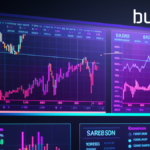The world of Forex trading is a magnificent tapestry, woven with myriad strategies, market theories, and trade executions. For traders—both neophyte and seasoned—the quest for techniques that offer not only a competitive edge but also consistency is perpetual.
It’s hardly surprising, given that the Forex market, which stands tall as the world’s leading financial market, astonishingly processes trades exceeding $6 trillion daily.
Amid this colossal turnover, the order block trading, with its nuanced insights and remarkable resilience, has emerged as a luminary.
An Exhaustive Insight into Order Blocks
Before diving deep, it’s pivotal to understand: What exactly are these order blocks? Expounding on this, order blocks can be envisaged as defined zones on a price chart where sizable trading orders have been stationed.
They are akin to the lighthouses for ships in the vast ocean, guiding traders through the tumultuous waves of market price movements.
By effectively doubling up as potent support or resistance markers, these blocks are the silent sentinels, hinting at potential tectonic shifts in market sentiment.
They essentially encapsulate the perennial tussle between supply and demand, offering a window into the heart of market dynamics.
Historically, the genesis of order blocks can be traced back to the heydays of institutional trading. Large traders, wary of the impact of their sizable trades, fragmented their orders to counteract market slippage.
Over time, these fragmented zones evolved into what we today recognize as order blocks. However, the eureka moment, when individual traders recognized the goldmine of opportunities these blocks might encapsulate, is a more recent phenomenon.
Deep Dive: Dissecting the Many Layers of Order Blocks
Peeling off the layers, every order block tells a tale—a tale of market aspirations, underlying sentiments, and potential trajectories. At a macroscopic level, these blocks gravitate towards two primary types:
- Bullish Order Blocks: These shine through especially after a distinct downtrend, forecasting a possible bullish revival.
- Bearish Order Blocks: Emerging after a pronounced bullish wave, these blocks subtly hint at the likelihood of a bearish downturn.
For traders with an appetite for detail, these blocks can further be dissected based on their intrinsic character—retracement or continuation. This granular distinction provides invaluable clues about the possible momentum of the market.
Sell Stop vs. Sell Limit: Peeling off the Layers
Anchoring our understanding of order blocks requires its effective translation into actionable trades. This is where the twin tools of Sell Stop and Sell Limit orders make their grand entry.
In the intricate lexicon of Forex, a Sell Stop order is essentially a directive to offload a currency pair once a specific, typically lower, price point is hit.
This becomes a trader’s best ally when anticipating a continued downward spiral post a certain price level. To elucidate, imagine the EUR/USD is trading at 1.1800.
Should your in-depth analysis project a drop post the 1.1750 threshold, placing a Sell Stop at this mark ensures you are strategically positioned to ride the anticipated downtrend.
Contrastingly, the Sell Limit order swings into action when the goal is to sell the currency pair at a price slightly above its current market position.
For instance, if the EUR/USD is anchored at 1.1800 but your meticulous market study anticipates a pivot around the 1.1850 mark, positioning a Sell Limit at this juncture guarantees that your trade harnesses the potential upside.
From a strategic standpoint, expert traders often nest their Sell Stop orders snugly below bullish order blocks, speculating on a subsequent market downturn.
In juxtaposition, Sell Limits are typically poised just above bearish order blocks, hypothesizing a price retracement following its climb.
Synthesizing Order Blocks within a Panoramic Forex Framework
The Forex market is a dynamic beast. Its rhythms and pulses change with time, making it imperative for strategies to evolve. While the intrinsic value of order blocks is undisputed, their true potency is realized when they are seamlessly integrated within a broader trading paradigm.
Consider a scenario wherein a bullish order block fortuitously overlaps with a crucial Fibonacci retracement level. This confluence can be a robust testament to an impending bullish surge.
Likewise, harmonizing order block methodologies with time-tested indicators like the RSI or MACD can elevate a trader’s predictive accuracy, creating a fortress of well-informed decisions.
However, as with all things Forex, a note of caution must be embedded. The market, with its multifaceted influencers, ranging from geopolitical undercurrents to sudden economic policy shifts, is unpredictably volatile.
Banking solely on order blocks, thus, might be a myopic approach, leaving traders vulnerable to unexpected market gyrations.
Advanced Trading Nuances: Beyond the Obvious
For the astute trader, the Forex market is a treasure trove interspersed with occasional landmines. Among these are the deceptively alluring ‘false’ order blocks.
These masquerade as genuine signals but are essentially market anomalies, capable of derailing unwary traders. An effective counterstrategy is to corroborate order block signals with trading volume data.
Authentic order blocks typically align with robust trading volumes, reinforcing their credibility.
Moreover, seasoned traders would vouch for the importance of adaptability. Even if an order block strategy yielded gold in the past, the market’s ever-changing pulse demands fluid strategies.
Continuous adaptation, unending learning curves, and perpetual innovation are the bedrock of sustained trading success.
Conclusion
Embarking on the Forex trading journey is akin to navigating a vast, often tempestuous ocean. Within this expansive realm, order blocks emerge as trusty compasses.
However, their true essence is unlocked when they’re synergistically merged with a plethora of strategies, insights, and tools.
As the ever-evolving tapestry of the Forex market unravels, traders, too, must evolve—remaining eternally inquisitive, perpetually adaptive, and forever striving for unparalleled excellence.







